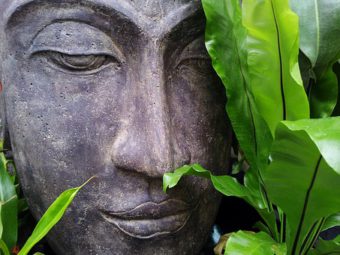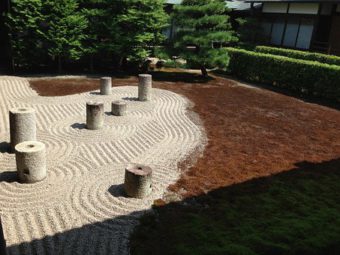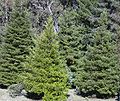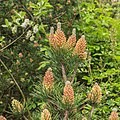In this article, we will be describing what container plants can be used for Japanese-style gardens. In order to succeed, you must understand that Japanese gardens reflect Buddhist philosophies and what this entails.
Buddha philosophies can be expressed when he said “I teach only two things. O disciples, the nature of suffering and the cessation of suffering”.
This is taught by the ‘four noble truths’ and ‘eightfold path’.

Buddha believed that nothing is permanent, as changes will always occur. The path to obtaining enlightenment is to practice and develop morality, meditation, and wisdom. Buddha believed that life is endless and subject to impermanence, suffering and uncertainty.
This is reflected in the garden, where Japanese gravel gardens, stroll gardeners, and tea gardens are seen everywhere in Japan. They are admired by people all around the world for the beauty and the tranquillity they bring.
TYPES OF JAPANESE GARDENS
The Japanese gravel garden, or Japanese rock garden, or Zen garden, is also known as a ‘dry landscape’ garden. This compromises large boulders and minimal planting. It creates a miniature styled landscape through carefully arrangements of rocks, mosses, trees and shrubs, water features and some plants.

Throughout the garden, gravel or sand is used and that it is often raked into patterns to represent ripples in water.
Traditional Zen gardens are small, surrounded by a wall and usually meant to be seen whilst seated from a single viewpoint outside the garden. Zen garden is intended to imitate the essence of nature and not its actual appearance. To serve as an aid to meditation and the meaning of life.
Japanese stroll garden is normally a large garden of connecting pathways that are often surrounded by a water feature such as a pond or waterfall. This would allow you to discover a new scene everywhere you walk.
Tea gardens, on the other hand, are more subdued and kept closer to local and natural items found in the garden. It often relies on pathways that have an outer and inner garden leading into a tea house, where the tea ceremony normally takes place. The type of garden is less bold and it is designed to keep it imperfect and rustic.
The stroll and tea gardens allow more plants to be used than a gravel garden. This includes beautiful topiary plants, colourful acers, bamboos, irises, and seasonal flowering Japanese shrubs such as rhododendrons and peonies.
You need to use a lot of winding pathways and water landscapes in open spaces to give an authentic look.
What follows are plants that can be used in Japanese style container gardens, to give gravel, stroll, or tea gardens their authentic look:
CALLICARPA BODINIERI VAR. GIRALDII (Beauty Berry)

This is an upright shrub with lance-shaped green leaves which produces minute pink flowers in summer. This is followed by purple berries. Look out for ‘Profusion’, which has purple-tinged young leaves that in autumn turn pink and produces light purple berries.
Grow this 1.3m tall plant in a large container full of multipurpose compost. It is best to have the compost on the moist side. The shrub does well in full sun or partial shade.
CRYPTOMERIA JAPONICA (Japanese Cedar)

A small, evergreen, roundish conifer that has scaly green leaves. In autumn cones are seen, which add attraction to the plant. Ideal to use in Japanese gravel garden to add a round shape between rocks. Grow this 1m tall conifer in a large container full of multipurpose compost in full sun. Can be used as a focal point in other types of Japanese garden.
FATSIA JAPONICA (Castor Oil Plant)

This large, 4m tall, evergreen shrub has large, hand-shaped, dark green, glossy foliage. In autumn, small, spherical, white flower heads appear, which are followed by black fruits. Grow this beauty as an attractive backdrop against a wall or fence in a very large container full of multipurpose compost in partial shade.
HAKONECHLOA MACRA (Golden Hakonechloa) ‘Aureola’

A 40cm tall slow-growing grass that has green-striped yellow leaves. As the leaves ages, it turns a red-brown colour, where in early autumn red-brown flowering spikes appear. The flowering spikes add interest in winter. Grow this plant in a container full of multipurpose compost in partial shade. Looks good in a gravel garden.
HYDRANGEA MACROPHYLLA (Lacecap Hydrangea)

This 2m tall rounded shrub that has large oval, light green leaves. From midsummer to early autumn, lacecap, flat domed flower heads appear that are formed of tiny, blue, white, or pink flowers, with little pink, white, or blue florets in the middle. Grow this plant in a moisture retentive multipurpose compost in partial shade or full sun.
HYDRANGEA QUERCIFOLIA (Oak –Leaved Hydrangea)

This mound-forming shrub has lobed green leaves that turn a beautiful red and purple in autumn. In midsummer to autumn, cream, cone-shaped flower heads appear that turn increasingly pink. Grow this plant in moisture-retentive ericaceous compost in partial shade.
IRIS LAEVIGATA (Japanese Water Iris)

A clump-forming perennial that has mid-green, sword-shaped leaves. In early summer, deep purple flowers appear with golden markings on the lower petals. Best to plant in a wet multipurpose compost in full sun, where it will grow up to 90cm in height.
PAEONIA (Peony) ‘Bowl of Beauty’

A 1m tall erect, clump-forming perennial that has divided green leaves and large, bowl-shaped double flowers with pink outer petals and white centres. This plant will contribute summer colour to a Japanese style scroll garden. Grow them in a pot full of multipurpose compost in full sun.
PAEONIA SUFFRUTICOSA (Tree Peony)

A 2m tall, upright deciduous shrub that has deeply, dark green, lobed leaves. In early spring, bowl-shaped, white, pink, red, or purple flowers appear that can be scented. Grow this in a pot full of multipurpose compost in full sun or partial shade, to give style to gravel or stroll gardens.
BAMBOO
What would a Japanese garden be without bamboo? When growing bamboo you need a large box container, the larger the better (minimum dimensions of 50cm in height by 50cm in depth by 1m in width, should be sufficient).
Bamboos prefer to be grown in enriched multipurpose compost in full sun or partial shade. Be warned bamboo can be very evasive and they can take over, which would require plenty of looking after to keep it neat and compact. You will need to cut out lower leaves and thin to make it look presentable.
PHYLLOSTACHYS BAMBUSOIDES (Japanese Timber Bamboo)

This 8m tall large bamboo has beautiful green or yellow canes with lush, green foliage. This will add height to any Japanese scheme, especially gravel gardens, or it can be used as a screen.
PHYLLOSTACHYS NIGRA (Black Bamboo)

This clump-forming bamboo has grooved green-brown stems that increasingly turns black as it matures. On the stems, long, narrow green leaves are displayed. This 8m tall bamboo makes an excellent living screen or a focal point in a stroll or tea garden.
SEMIARUNDINARIA FASTUOSA (Narihira Bamboo)

This shorter, vigorous bamboo produces clumps of dark green canes and lance-shaped, dark green leaves, which are grey-green underneath. Ideal as a screen in a gravel garden.
PIERIS JAPONICA (Lily of the Valley Bush)

A large, evergreen shrub that has glossy, dark green leaves when mature. The leaves whilst young are bright red, which then turns to orange, then light green before reaching their final stage of dark green. In spring, urn-shaped white or red flowers appear the cover the shrub. row this shrub in a large container full of ericaceous compost in a sheltered site.
PINUS MUGO (Dwarf Mountain Pine)

The Japanese love pines and they are highly prized for their scaly bark and elegant forms. Grow this pine amongst boulders in a gravel garden in container full of multipurpose compost in full sun. This 1m tall, compact evergreen conifer has mounds of dark green, needle-like leaves.
PRUNUS INCISA ‘Kojo-No-Mai’
This 2m tall flowering cherry tree signals the beginning of spring with an abundance of white flowers that signals the end of winter, which can last until April.

After flowering bronze tinged leaves are produced on zigzag branching structures, which darken to a vivid orange colour in autumn. This tree will provide interest from spring all the way to autumn.
Grow this dwarf cherry tree in gritty, well-drained multipurpose compost in full sun or partial shade in a large container. To keep in shape and to keep the tree compact, prune regularly.
RHODODENDRON INDICUM

This is, in fact, an Azalea, which grows up to 1m in height. This short, evergreen plant has long, oblong-shaped slightly toothed, dark green leaves. The leaves take on a red tinge in winter. In late spring, funnel-shaped, red or dark red flower are borne on trusses.
Grow this beauty in a large container full of ericaceous compost in partial shade, Use in stroll and tea gardens for extra colours. Look out for Rhododendron dilatatum as a wonderful alternative.
SARCOCOCCA HUMILIS (Christmas Box)

A 60cm tall, very compact, clump-forming, evergreen shrub that has glossy dark green leaves, which can be clipped into a spherical shape. In winter, tiny, fragrant, white flowers are seen and look beautiful in gravel gardens. Grow this plant in a moisture retentive multipurpose compost in partial or total shade, where the black berries that form after flowering can be admired.
VIBURNUM DAVIDII

This 1.5m tall, evergreen shrub that has dark green, deeply veined leaves, where in spring, white flowers appear. Female plants bear decorative, metallic blue fruits if both sexes are grown near to each other. Grow this plant as shade for other plants in a multipurpose compost.
CONCLUSIONS
In this article container plants for Japanese-style gardens have been discussed. There are 3 distinct forms of Japanese garden, each having a different style as described in this article. If you do not like one design you can use another, as long as they meet the Buddhist philosophies.
The plants will add beauty to the Japanese container garden and will suit the eloquent scheme well.
If you have any questions or comments that you wish to raise, please do so in the comment box below.
Domo Arigatou

Well this post has really hit home with me, I have enjoyed reading this article, because not only do I love my garden but I also love Buddhism, I’m not a practicing Buddha or anything like that but I have always been interested and found it to be an interesting believe system, in fact I do have a small zen Buddha statue in my garden, but I have never given any thought to converting my garden into a Buddhist theme and I can say that after reading your post here I am seriously considering doing just that, in fact, I think it would look great, thank you for sharing this.
Hi Russ
Thank you very much for those kind words. In my articles I am trying to get people to think about all the possibilities you can have on your container garden. This is why the idea of a Japanese style garden came about and why people should adopt them.
Kind regards
Antonio
Now when I usually see an article that talks about Japanese garden plants it’s not something that would pick my interest but in all honesty I started reading and found your information very captivating. I like that you provide a wide variety of plants that can be used in such a garden, giving many options ensure that people will find something they like. I did enjoy reading your article very much and I learned something that otherwise wouldn’t have a clue about. Thank you for the share!
Hi Stratos
Thank you for those kind words. I feel my job is to get people to think about all the possibilities and then apply them to their own designs. I have so many choices coming up soon.
Thanks
Antonio
Wow this is really amazing, these Japanese style gardens are really nice, this is actually the first time I’m reading about it and I think it’ll be a great idea to have one around one’s house, especially the stroll garden, I so much love it. The plants are so nice and beautiful, I like the Hydrangea quercifolia the colour is what I like. I’ll try to find a way around making my own Japanese garden. Thanks for this amazing information, it’s very useful.
Hi DreaJay
It always gives me a good glow when someone makes a good comment like yours. My role is to broaden people’s horizons, so that they can apply to their own gardens designs which they first thought as impossible. I am glad you are thinking about it.
Thanks
Antonio
Thank you for this great article. It makes sense that Japanese style Gardens reflect Buddhist philosophies. Thank you for all the suggestions of different plants you can use in a Japanese style Garden. And for explaining how the different garden layouts you suggested are ideal because they reflect Buddhist philosophies. Thank you for your expertise on container gardening and have a great day.
Hi C
Thank you for stopping by and commenting. It is always good to see your hard work is very much appreciated and that people are adapting more influences from abroad and apply it to their own garden.
Kind regards
Antonio
Hi, It doesn’t get much more relaxing then gardening. I have never read about Japanese style gardens. I have not seen one either. They have many beautiful plants.
Coincidentally, I think Buddhism is an interesting thing to study. In particular Zen.
These look like they are pretty cool plants and flowers. They are beautiful. After I finish writing this I am going to check out pictures Japanese Gardens on google images.
Thanks for the great article. This is a cool website.
Hi Jake
Thank you for stopping by and commenting. Japanese style gardens are beautiful and peaceful. More importantly they get you thinking about many things, which in the long run will make you a better person. I am glad you got inspiration from it.
Kind regards
Antonio
Hi, they are a smart and awesome country for sure.
Hi Jake
Thank you for stopping by and commenting.
Antonio
I can only imagine how beautiful these Japanese gardens must look. I see they put a lot of effort and skill in crafting these gardens. Those winding paths and water landscape sound like a great adventure in a garden. I understand how these gardens are meant to connect you with the natural environment. I love plants that are green all through out the year without much effort. The Japanese Cedar is what I would really consider for my garden. The beauty berry and the Lacecap Hydrangea in their color is just perfect for any garden.This clearly gives you some clarity in life as you let the beauty of nature sink in. Thank you for this great article.
Hi Carol
Thanks for those insightful words, which I believe has hit the nail on the head. The gardens are simple and reflective. It will bring order to your life and should be adopted by gardeners in general.
Kind regards
Antonio
wow! truly is the saying that learning never ends. I just learned another thing that i’m sure would help me to improve better in my gardening. The Japanese style seems to mirror life and the essence especially the fact that it follows the Buddhist philosophies. It’s actually nice. I feel that if I ever try to practice this container gardening style, I will favour to plant the Hydrangea lacecap. It looks very beautiful.
Hi RoDarrick
Thank you for your frequent visits and comments. I am glad you got a lot from the article, as Japanese garden are simply beautiful and practical. If you want to impress your family and friends, you should adopt one today.
Kind regards
Antonio
I like the Japanese container garden style which is mirrror to follow the buddhist. To be honest, this is the first time that i am coming across this and it seems very interesting enough that I wish I can try it out. It would surely be worth it since you have given so many list of plants that can be added to the garden to make it worthwhile. Thumbs up to you for this.
Hi Shelley
I am glad you are keen to try the Japanese style garden, as it will bring so much harmony and joy to you and your visitors. It is well worth the time and effort.
Kind regards
Antonio